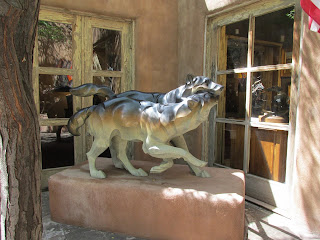The Museum of Indian Arts & Culture, the Wheelwright Museum of the American Indian, the Museum of Spanish Colonial Art, the Museum of International Folk Art and Santa Fe's Botanical Gardens are the major attractions located on Santa Fe's Museum Hill. We took the opportunity for a group photo in front of the "Journeys End" sculpture.
Here is a snip-it of each museum.
Museum of Spanish Colonial Art was founded in 1925, the Museum of Spanish Colonial Art was established for Hispano Arts from the southern Colorado and New Mexico region. Today, the collection has been enlarged to include Spanish Colonial objects from around the globe dating from Medieval Times to the modern world. It features more than 3,700 artifacts and works of art.
The Museum of Indian Arts & Culture tells the stories of the peoples of the Southwest through Native American art and objects that span from the prehistoric times to the contemporary world. The museum offers an extensive collection of more than 70,000 works objects that range from statues and pottery to baskets and artifacts and features a state-of-the-art Living Traditions Educational Center, which is its multi-use exhibition space and educational center with a library and Museum Studies Center.
The Wheelwright Museum holds the distinction of being the oldest non-profit private museum in the state of New Mexico. Housed in an octagonal-shaped building that takes its inspiration from the Navajo "hooghan," the Wheelwright Museum of the American Indian is dedicated to displaying exemplary works of art in the Native American tradition. The Case Trading Post offers contemporary art and craft items created some of the Southwest's finest living artists and craftspeople for sale.
Art is not just at the museums, it is all over Santa Fe. There are three art districts, Downtown, Canyon Road and The Railyard. The Downtown Arts District is in walking distance to more than twenty member galleries plus the Georgia O'Keefe Museum, New Mexico Museum of Art, and Native American vendors under the portal at the Palace of the Governors.
Santa Fe's historic Canyon Road is a long, winding thoroughfare lined with centuries-old adobe teeming with art. The Canyon Road Art District is home to more than eighty galleries. The older signs indicate "The Art & Crafts Road" but it is much more than that connotation.
In 2016, Santa Fe's newest arts district, The Railyard, was voted one of the nation's 10 Best art Districts in a USA Today Readers Choice poll. At this district the spaces are big and modern, and the art is too. Culture vultures also enjoy nearby SITE Santa Fe, author George RR Martin's Jean Cocteau Cinema, and free summertime events in Railyard Park.
The bus parked near the New Mexico Museum of Art, and it was a short walk to the Palace of the Governors and the Plaza. After a short history on the Plaza and the statue in the center, we headed to the Loretto Chapel. The exterior is breathtaking and a small tree by the entry holds hundreds of rosaries.


The Loretto Chapel is a place of great mystery surrounding their spiral staircase. Here are the details, as we heard them. A chapel was constructed somewhere in the 19th century. When it was ready, the nuns found that there was no staircase built to take them to the top level. They spent 9 days praying to St. Joseph, who was a carpenter. On the last day, a stranger knocked at their door and said that he was a carpenter who could help them build the staircase. The nuns saw him soaking wood in barrels. He constructed the staircase, all by himself, which was considered to be the pride of a carpenter. No one knows how the staircase could stand by itself, as it did not have a central support. Then the carpenter disappeared without even waiting for his payment. There was a rumor in the city of Santa Fe that the carpenter was St. Joseph himself, sent by Jesus Christ to attend to the nuns' problem. Since then, the staircase was called "miraculous."
There are three mysteries about this staircase, says the spokesman of the chapel. The first mystery is that, to this day, the identity of the builder is not known. The second mystery is that the architects, engineers and scientists say that they cannot understand how this staircase can balance without any central support. The third mystery is from where did the wood come? They have checked and found out that the type of wood used to build the staircase does not exist in the entire region. There is another detail that has just increased the belief in the supposed miracle: The staircase has 33 steps, the age of Jesus Christ. Something like this can turn a non-believer, into a believer!
Our tour guide, Peter, left us after the tour of the chapel and we had time to wander the Plaza and the shops on our own for an hour. The two Charlies went to the Plaza to sit in the shade with Lowell and Janet. Nancy and I headed to wander some of the closer art galleries and shops.

We met back at the bus and headed to our lunch destination, Cowgirls. The private catered lunch was authentic Mexican cuisine. It was delicious and very enjoyable.
 After lunch, the bus returned us to the RV resort. Some of us planned on heading back to the Botanical Gardens, but Mother Nature had other plans!
After lunch, the bus returned us to the RV resort. Some of us planned on heading back to the Botanical Gardens, but Mother Nature had other plans!At 7 pm on day 29, we had our final get together, there were favorite times on the caravan shared, a few tears, lots of laughter and many, many see you later ... we don't like to say good bye!
Stay tuned for Day 30 of 30!

















No comments:
Post a Comment